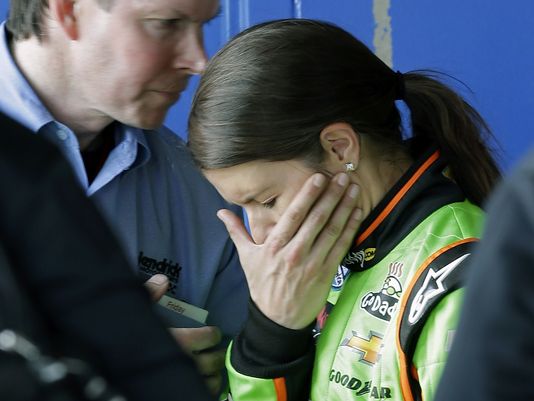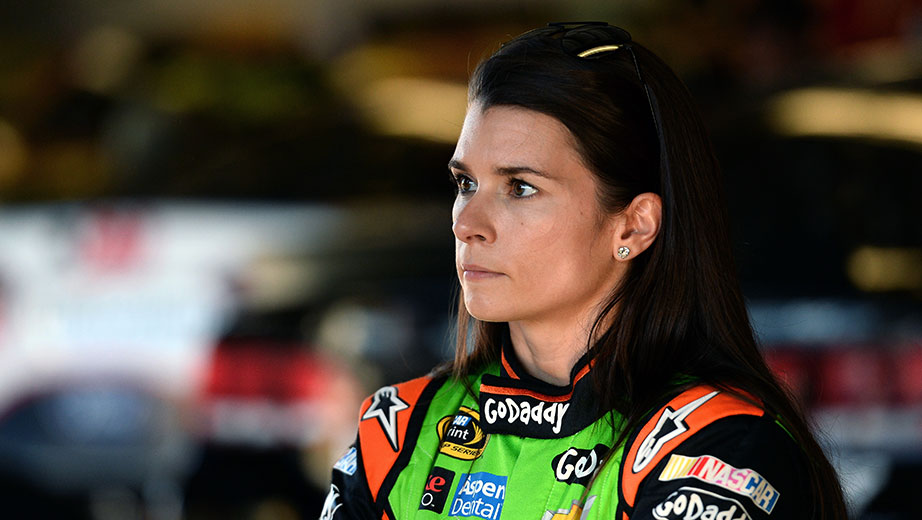Sad day for NASCAR fans

I can't believe it's been 23 years since we lost NASCAR Champion Davey Allison.
It was on this day in 1993 when his helicopter tragically crashed at Talladega 🙁
It's the saddest – and cruelest – form of "what if?" speculation: What if so-and-so hadn't died? How would history and the world as we know it have been different if this person had lived?
Unfortunately, motorsports provide plenty of "what if?" opportunities, given the fatal potential for participants on auto racing's worst days.
On this date every year, the "what if?" in Alabama involves Davey Allison.
Son of Bobby Allison, nephew of Donnie Allison, protégé of Red Farmer, Davey Allison was carrying forward the banner for the Alabama Gang. But 23 years ago today, the NASCAR star suffered serious injuries at Talladega Superspeedway – not in a wreck on the world's largest racing oval, but in a helicopter crash in the infield on July 12, 1993.
Allison died a day later at a Birmingham hospital.
Dale Earnhardt Sr. also had his career ended prematurely, dying in a crash on the final lap of the Daytona 500 on Feb. 18, 2001. The "what-if" stories on Earnhardt have focused more on the acceleration in safety advances in NASCAR prompted by his death than about how the racing record book might have changed. The Intimidator had 22 full seasons in NASCAR and won seven championships and 76 Cup races.
But almost two decades ago, Earnhardt speculated on how Allison's death affected NASCAR.
"I think Davey would definitely been champion, champion over several times probably," Earnhardt said. "Who knows? I might not be seven-time champion if he was still alive. He'd have beat me out maybe a year or two. It's just hard to figure, hard to figure how it would have turned out."
A look at the Alabama Gang — Red Farmer, Neil Bonnett, Donnie Allison, Bobby Allison and others — who ruled NASCAR tracks in their day and put Hueytown in the racing spotlight.
Davey Allison – 1994 Winston Cup champion?
Was Earnhardt right? Yes, on at least two counts.
First, it is hard to figure – and impossible to know — how it would have turned out, especially if all the "what ifs?" that might have impacted the Allison "what if?" are considered. What if Alan Kulwicki hadn't died in 1993, too? What if Tim Richmond hadn't died in 1989? What if Tony Stewart had stuck with open-wheel racing? And on and on.
Second, based on the statistical evidence, Allison would have become a NASCAR Winston Cup season champion.
But what about Allison costing Earnhardt one of his seven championships, tied with the King himself, Richard Petty, for the most in NASCAR Cup history? That one seems less certain.
Earnhardt won his championships in 1980, 1986, 1987, 1990, 1991, 1993 and 1994.
Allison earned the NASCAR Winston Cup Series Rookie of the Year Award in 1987 and raced his first full Cup season in 1988. In 1991 and 1992, he posted consecutive third-place finishes in the series' season standings.
When Allison died in 1993, 16 races into a 30-event Cup schedule, Earnhardt sat on top of the standings – 171 points ahead of second-place Dale Jarrett and 323 points in front of Allison in fifth place. Earnhardt went on to capture the 1993 pre-Chase title by 80 points over Rusty Wallace, who won five of the final 14 races and made up 170 points.
It doesn't seem likely Allison would have denied Earnhardt the 1993 championship.
The next season is another story, though.
After Allison's death, Yates Racing skipped an event, then had Robby Gordon in the No. 28 Texaco/Havoline Ford for a somber Die Hard 500 at Talladega Superspeedway on July 25, 1993. The No. 28 got on the track only four more times that season, with Lake Speed at the wheel.
In 1994, Yates Racing put Ernie Irvan in the "Battlestar," and coming off a second-place finish at Watkins Glen in the 20th race of a 31-event season, Irvan was 27 points behind Earnhardt at the top of the Winston Cup standings. Each driver had three victories, and third-place Rusty Wallace was 299 points behind Irvan.
But the next week at Michigan International Speedway, Irvan had a horrific wreck in practice that nearly cost him his life. It did cost him the rest of the 1994 season and almost all of the 1995 campaign, too.
Kenny Wallace stepped in for Irvan in 1994. Between the two drivers, the No. 28 Ford accumulated 4,439 points, which would have been second in the final season standings to Earnhardt's 4,694. But what if that had been Allison in the car for the 1994 season? Would Earnhardt be one of NASCAR's two six-time champions (along with Jimmie Johnson) instead of one of the two seven-time champions?
Which other years might Allison have won the title?
Perhaps rather than Earnhardt, it's one of the other champions from the 15 years after Allison's death that might have lost a Cup title to the Hueytown driver. In that span, Jeff Gordon won four championships, Johnson three and Tony Stewart two. Jarrett, Terry Labonte, Bobby Labonte, Matt Kenseth and Kurt Busch won one title apiece in that time.
Which of those titles might have gone to Allison, perhaps joining his 1994 crown?
The 1996, 2002, 2004 and 2005 championships seem particularly vulnerable.
In 1996, Allison still would have been working with crew chief Larry McReynolds at Yates Racing. Terry Labonte won the 1996 championship by 37 points over Gordon, even though Gordon won 10 races and Labonte won two. Jarrett finished third, only 89 points behind Labonte, and he would have been Allison's teammate at Yates Racing (unless, of course, he still was at Joe Gibbs Racing without the opening caused by Allison's death and Irvan's accident).
During the 2002 season, 18 drivers won at least one race. Stewart won the championship with three victories and 4,800 points – the lowest winning total in a 36-race season. Mark Martin finished 38 points behind in second place with one victory.
The 2004 and 2005 seasons were the first two under the Chase system (and as the Nextel Cup Series). The 10 tracks in the races in the NASCAR "playoff" in those years included four of the 11 on which Allison won Cup races, with Charlotte, Dover, Phoenix and Talladega accounting for eight of Allison's 19 victories (plus two more in All-Star races).
In 2004, Johnson won four of the final 10 races, but Kurt Busch finished eight points ahead of him at the top of the final standings, with Gordon just 16 points behind in third.
In 2005, Stewart captured the championship by 35 points over Greg Biffle and Carl Edwards without winning any of the final 10 races.
Stats forecast championship for Allison
What's the likelihood that Allison would have won a championship?
History says he would have.
Only two drivers who started their careers after Allison have won races at a better rate than he did – Gordon and Johnson, who have 10 championships between them.
Allison competed in 191 Cup races. He won 19 times (not counting his two victories in the annual All-Star, non-points event). That's a winning percentage of 0.0995.
Fourteen drivers who competed in at least as many Cup events as Allison did and participated in at least one full season of Cup racing have a better winning percentage than Allison. All of them won at least one NASCAR Cup season championship.
In fact, those 14 drivers — Herb Thomas, David Pearson, Richard Petty, Cale Yarborough, Jimmie Johnson, Ned Jarrett, Lee Petty, Rex White, Bobby Isaac, Bobby Allison, Jeff Gordon, Dale Earnhardt Sr., Joe Weatherly and Darrell Waltrip — combined to win 44 of the 66 season titles in NASCAR history.
The next three drivers on the winning-percentage list after Allison who competed in at least as many Cup events as he did and participated in at least one full season of Cup racing also have won championships. Those drivers are Tony Stewart, Kyle Busch and Brad Keselowski.
There are three drivers who participated in at least 191 Cup races who have a better winning percentage than Allison but didn't win a season championship. None of the three – Fireball Roberts, Junior Johnson and Speedy Thompson – ever ran more than 80 percent of any season and, consequently, never won a title.
Allison's team owner, Robert Yates, told Marty Smith of ESPN of Allison: "He would've been up there with Jimmie Johnson. He'd have been as good as anybody ever. On driving alone, I'm not sure he couldn't outperform any of them, all of them, anybody ever. He was amazing."
Allison's support team
But driving talent alone isn't usually enough to win championships. It takes a championship-caliber team. Would Allison have had that?
The Yates Racing's performance in 1991 and 1992, when Allison won 10 of the 58 Cup races and finished third in the final standings in both years, would indicate he would have, as does Irvan's performance in 1994 before his terrible accident – another somber "what if?" moment for NASCAR.
Owner Yates and crew chief McReynolds soldiered on together for three full seasons after Allison's death.
With Irvan unable to drive in 1995, Dale Jarrett came over from Joe Gibbs Racing to pilot the No. 28, still with the Texaco/Havoline sponsorship. He recorded one victory and placed 13th in the final standings. But better things were ahead for Jarrett at Yates Racing. He switched to Yates' No. 88 the next season and stayed in it for 11 seasons, winning the championship in 1999, part of a six-year stretch in which he never finished lower than fifth in the final standings.
Without Allison, the No. 28 did not fare as well, using three drivers over the next seven seasons.
Irvan returned to Allison's seat in 1996, won two races and finished 10th in points.
Irvan was back in 1997, but McReynolds had left for Richard Childress Racing to sit atop Earnhardt's pit box. With Marc Reno as crew chief, Irvan had one win and a 14th-place showing.
In 1998, Yates put Kenny Irwin Jr., the 1997 NASCAR Craftsman Truck Series Rookie of the Year, in the No. 28. Although Irwin earned the Winston Cup Series Rookie of the Year Award, he failed to win in two seasons with Yates, even while teammate Jarrett was the circuit's top driver.
The No. 28, still with the Texaco/Havoline sponsorship, had a revival with driver Ricky Rudd and crew chief Michael McSwain. Rudd finished fifth in the 2000 standings and fourth in the 2001 points.
After Rudd's 10th-place showing in 2002, he left to join the Wood Brothers, and Yates had a new primary sponsor, Mars, on a new car number, the 36, for driver Elliott Sadler.
Jarrett and Sadler raced as teammates for four seasons, but Yates Racing had only four more victories left on its ledger. It merged with Richard Petty Motorsports after the 2009 season, with 57 victories in 1,155 Cup races.
That happened 16 years after Allison's death, but the demise of Yates Racing still is one of the "what ifs?" raised by the driver's death 23 years ago.
Политика конфиденциальности | Правила пользования сайтом














